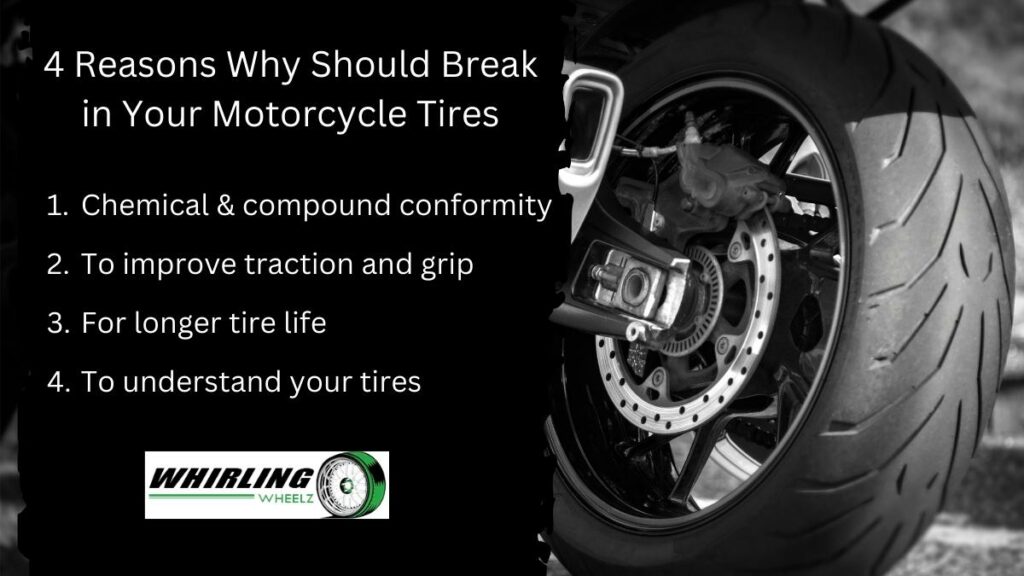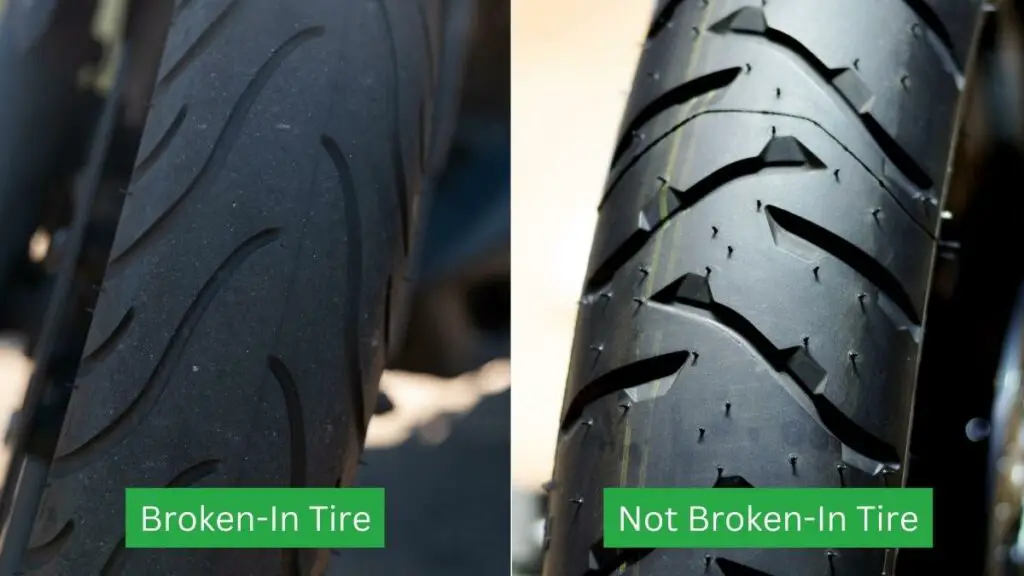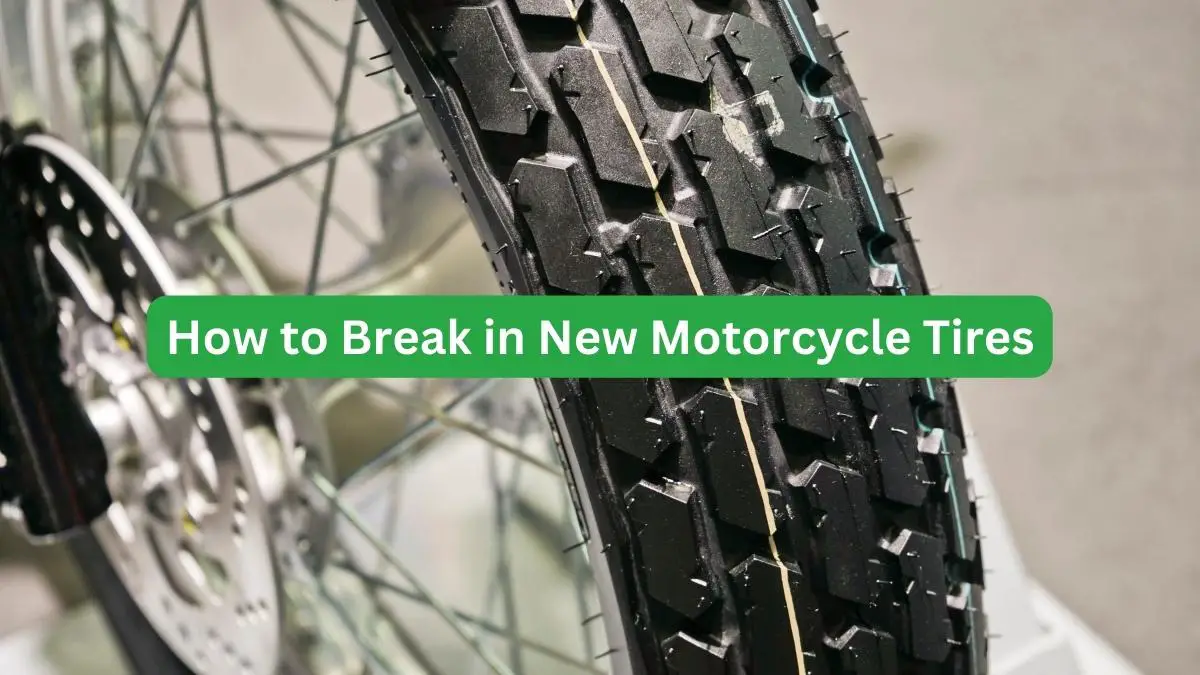One of the biggest things you will do as a motorcycle rider is buying a new set of wheels for your big toy.
The choice of new motorcycle tires often depends on your handling characteristics and bike type.
Whether you choose grippier compounds or longer-lasting sets of wheels for daily touring, the tires always look smooth when they are new.
Therefore, the tires must be broken-in to ensure they are in perfect running condition and handling. The trickiest part of this process is knowing when the break-in period is done and how to do it.
The most effective method to break in your tires is riding your tires for more than 100 miles (160 km). Riding new tires keeps them heated up which will help in loosening the compounds used in making the tires. This process scrubs off the smooth surface to improve traction.
Here is a breakdown of all the activities that will help you break your tires without damaging your wheels.
What Does it Mean to Break in Tires?
Breaking in sometimes is called conditioning or running, which means removing the slippery release agent coating on the new tires to improve the grip.
New motorcycle tires look different from the ones that have already hit the road several times. They appear glossy because most manufacturers use release agents on these tires to ensure they clean out the mold.
Although this benefits the manufacturer, it might disadvantage you because the rubber will not have enough grip.
Some riders use belt sanders on the tires from side to side or wash them using harsh chemical baths. However, these methods are possibly dangerous for your ride.
Why Should You Break in Motorcycle Tires?

Chemical and Compound Conformity
After buying a motorcycle, you will realize that not everything was done during manufacturing, so you cannot take it speeding in the sun. Afterall, multiple chemicals and compounds go into making a single motorcycle tire.
These components work together when the tire heats up to create a rigid combination. First, check the tire specifications to determine the suitable break in temperature. For example, riding for 10 minutes at tire temperatures of 165 degrees F (73°C) can easily break in the tires.
To Improve Traction and Grip
Motorcycle tires are very glossy when they are fresh off the shop. Manufacturers add this gloss to improve appeal considering buyers will pick a new bike with shining tires. However, this gloss only looks good when the motorbike is still parked.
The tires might not hold well on the tarmac, and a break-in period is needed to conform to the asphalt. Riding at slow speeds for around 160 km (100 miles) wears off the gloss and scrubs the surface to allow more traction.
For Longer Tire Life
Naturally, if you go riding in the streets on a new set of wheels, you will find yourself running out of grip sooner than you imagined.
Alternatively, if you break in your motorcycle tires by riding them on the highway, they will last longer. This method works better than improper break-in methods like sanding and hand scuffing.
To Understand Your Tires
Another reason you should try to break in your tires is to become comfortable with the tire. The ride quality and handling alter when you install a new set of tires. Therefore, acclimatizing to new settings is crucial for your safety.
A huge difference is even when you choose the same set of tires as the older ones you had. If the older ones had a flat profile, and the latest ones had a round profile, this break-in period is deserving.
How to Break in New Motorcycle Tires
First of all, breaking in new tires is a gradual process. The tires will not be fully broken in until the entire contact patch of the tire is scrubbed properly, all the way from the center to the sides. The first few kilometers are crucial because they determine the success of the break-in.
During the break-in period it’s all about being gentle on the throttle and brakes while going easy on corners. The slick surface on the new tires needs at least 100 miles (160 km) to be fully broken in.
The center band of the tires will be broken-in first as they are in the most contact with the ground. This means that the sides of the tires will take more time. It’s important to let the sides break-in fully before you start riding corners at higher speeds since the available grip will likely be less than a well-scrubbed tire.
To break in the sides of your tires you should ride through twisty roads while taking it easy on the corners. You should do this for another 30-50 miles depending on the tire type and quality you have.
Tips For a Better Break-in of Motorcycle Tires
Do Not Weave Around
Professional racers weave around to retain heat of tires after pre-warming them. However, this will not help an ordinary rider warm up street tires. Weaving puts you at a higher risk of your bike falling down on its sides since the tires don’t have the full level of grip yet.
Drive in Slow Figure-8s
Consider using your motorbike like a teenage rider who just landed his hands on one. Find an open space and make a lot of slow figure-8 turns.
Doing this is the safest way to scrub the edges of your motorcycle tires.
Stick to Cruising Around
The break-in period is not when you decide to go hard on the throttle and do knee-downs on corners. This is perhaps the biggest temptation among new riders or seasoned drivers with new tires. Instead, try to cruise slowly and go easy on your tires.
Regularly Check your Tires
While you might be excited about breaking in your new tires, doing it at the wrong pressure could be damaging.
Breaking in at wrong pressures may affect long-term handling and performance. Therefore, try to monitor the tire pressures and adjust when necessary. Firmer tires tend to break in better because they retain heat better.
Be Patient
Trust their words when the manufacturer says you should break your tires at 200km (124 mi). The process will be slow and tiresome, but that is how you get the best results. Do not rush into sanding your tires to speed up the process.
Try to perform your starts in warm and dry weather for the treads to better grip within a short time. If you live in cold areas, maybe consider going for over 250 km (155 mi) to ensure your motorcycle tires are well covered. Once you hit the 200km (124 mi) mark, do not jet off the driveway immediately.
Instead, keep going around the block until your motorcycle tires feel warmer when you touch them. You can cut them loose at this point, and even if there is a slippery edge on your tires, the warmth will scrub them off without sliding.
How Do You Know That Motorcycle Tires Are Broken-In?

You will realize when your motorcycle tires are broken in because they will have an evenly rough surface, as in the image to the left.
The once-new shiny and smooth tires would be scuffed up across the entire surface from one edge to the other if you took your time leaning in for an even break.
How Long Does It Take to Break in Motorcycle Tires?
According to manufacturers, the first 100 miles (160 km) are crucial in scrubbing the tires to remove the slick surface. Then, the break-in mileage can extend to between 1000 and 1500 km (621-932 mi) for better results. From here, you can proceed to acclimate them to even tougher riding conditions.
Start at moderate speeds in the first 100 miles (160 km) and improve your lean angle as you proceed. Speed management helps the tires handle better, so avoid high revs and hard cornering. However, the period it takes to break in depends on the type of motorcycle tires.
For the first 500 miles (804 km), ride slowly and gently to allow the tires to set properly. After that, you can take weeks to months riding around, provided you meet the mileage threshold. After riding for 500 miles (804 km), you will tell whether your tires are becoming comfortable and your grip is improving.
Heat or No Heat When Breaking in Motorcycle Tires?
Heating new motorcycle tires is always a concern because heat is considered an enemy of rubber. In this case, heat should be your tire’s best friend. It would help if you tried to heat the tire to the appropriate temperature.
To avoid ruining the tires, do not raise the temperatures above 200- and 210 degrees Fahrenheit (93-98°C). Instead, new tires should be heated to around 165 degrees for a few minutes before pushing the bike beyond its limits. To bring the bike to appropriate temperatures, consider hard riding for around 30 minutes.
What Should You Watch Out For on Motorcycles Tires During Breaking In?
Sometimes, when trying to condition your new tires, they could degrade or worsen your riding experience. Therefore, you have to look at these few things to ensure that your bike’s tires are still in perfect condition.
Dry Rot
Before getting into the minor details, look over your tire after the break-in period to spot any signs of dry rot or cracking. Even when everything checks out, this might be a death sentence for your wheels.
Damage
The other obvious thing you need to check for is tire damage. Missing chunks, bulging in the sidewall, flat spots from sitting for too long, excessive tread wear, and pictures are enough to show that the tires are damaged.
Unfortunately, you never know when your bike will get punctured, even with new tires. It is, therefore, best to keep checking your tires within the first 500 miles (804 km) to ensure you enjoy the most of them.
Squared-Off Tread
If you do not notice any dry rot on the tire, the next thing to do is inspect the tread profile. When you drive a motorcycle aggressively for longer distances, you might eat into the treads even if they are new.
As a result, the treads may start to flatten out in the center, which causes uneven braking. To avoid squared-off treads, it is advisable to ride slowly and take corners for an even breaking-in and an increased tread contact patch.
Myths About Breaking in Motorcycle Tires
When it comes to breaking in tires, most people consider using sanders and chemical washes to remove the agent layer. The problem with these methods is that they could potentially damage your tire and make the ride more dangerous.
Chemicals interact with the rubber compound to degrade the quality of the rubber, which makes it unsafe and causes premature wearing out. In addition, scuffing up the tires causes low spots because you will sand off too much rubber.
Even though it may go faster, it goes without mentioning that sanding the entire wheels takes more effort than it would simply riding around, not to mention that going for a ride is arguably more enjoyable.
Moreover, these two methods result in uneven tread wear patterns and manufacturers invest a lot in R&D to find the best tread for your tires, so try not to ruin everything.
Summary
As you can see, breaking in new motorcycle wheels is not a hard task. All you have to do is follow this guide and find what works for you.
The mileage period will depend on how frequently you ride your bike and your experience level.
The main goal should be getting a motorcycle with wheels that can take you anywhere without being problematic.
Hi, my name is Niklas, the head content creator & CEO of Whirling Wheelz. I am very interested in vehicles of all kinds, mainly cars. I have a car mechanics degree from high school and a big hobby of mine is to follow the WRC (World Rally Championship) both online and through travel.


